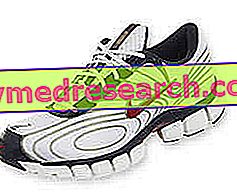By Dr. Stefano Casali
1. Choice of shoe in relation to the weight of the athlete
It is evident that the weight of the athletes can vary considerably depending on the somatic characteristics, sex and sports specialties that we are going to consider; a shoe built and structured for light athletes would not lend itself to being used by a heavy athlete as the materials used, the shock-absorbing abilities of the antishock systems and the structure of the shoe itself are designed for use by a "light" athlete ;

2. Choice of shoe in relation to the training ground
Another important aspect that the athlete should consider when choosing a shoe is that relating to the fund on which he will have to perform his own training; excluding the specialized footwear, a classic running shoe has a moderately treaded sole that allows a good yield on almost all surfaces (tartan, asphalt, grass, sand, linoleum etc.) but that loses its adhesion characteristics on unpaved surfaces muddy. Just like for the motocross racer who equips his vehicle with knobbly tires, the athlete who trains on heavy grounds needs shoes made specifically for this use: the salient features are to be found in a considerably more robust structure that often goes hand in hand with a greater weight and a strongly tessellated sole, which allows an optimal grip on heavy grounds. Therefore, if the athlete decides to carry out his own training on this type of terrain he will necessarily have to keep in mind that the use of these specific footwear can guarantee greater safety, as the best grip can protect him from slipping and consequent possible injuries which they can affect the training session or even condition the entire preparation.
3. Choice of shoe based on the type of foot support
Many practitioners, probably, after a continuous use, will have noticed on their running shoes the signs of wear that often occur with the consumption in the internal or external area of the heel, and, in some cases, with the yielding of the upper front area internal or external that can even get to tear. A bit like when we happen to check the tire wear on our car and see that we have worn them unevenly perhaps due to a "to be redone" convergence, an analysis of the shoe at the end of the its "life cycle" can help the technician and the athlete to identify the support characteristics and, in the light of any anomalies, direct them towards the choice of a shoe with different characteristics. A useful aid is provided by the baropopodometric examination which can be performed dynamically by walking or running over a special platform equipped with special sensors, the athlete sends the data relating to his plantar support to a computer that shows on the display in real time how and measure it uses the foot in all phases of support. The data of the baropodometric examination are therefore very important because, besides being fundamental for the construction of a possible footbed, they can direct the athlete towards the choice of a shoe that is really suitable for his own support characteristics. If the subjects with a normal type of support or with a tendency to supination will be directed towards a different type of shoe with "neutral" characteristics, it will be the choice that will be made by the athletes who are classified as overpronators. For these subjects who show a marked pronation of the foot in the dynamic phase, in fact, almost all the main shoe manufacturers have in their catalog special models called "anti-proclamation". The salient feature of these shoes is to present a special insert in the inner middle area, usually in plastic material, which has the task of supporting the athlete's foot, thus offering valid support during the race and other dynamic actions. are studies and evidences that can be objectively evaluated that put the plantar support in close relation with the subject's overall posture and that, both in the case of athletes and in that of "Sunday sportsmen" make us reflect on how this aspect should be treated and considered like others when you are working with them, whether they are adults or children in developmental age.



